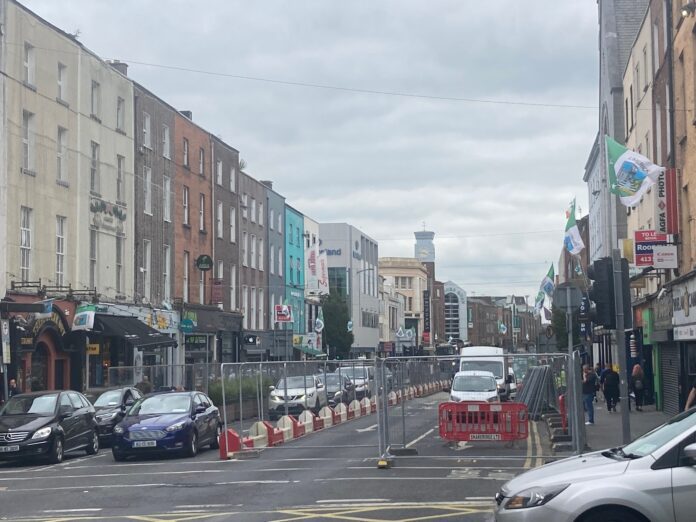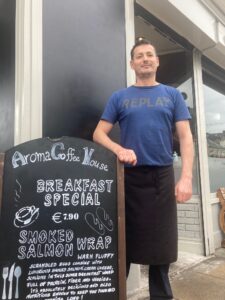
ASIDE from the pandemic, and Limerick’s All-Ireland hurling victory, the main topic of conversation among traders in the Treaty City is “pedestrianisation”, and how it will impact their businesses.
The Limerick hurlers are odds on favourites for an Liam MacCarthy treble next year, however the jury is still out on Limerick City and County Council’s plans to pedestrianise streets, create more cycle lanes, in its aim to create “a liveable Limerick”.
The city centre is being dug up, bulldozers and jack-hammers are presently uprooting a section of O’Connell Street, as part of the Council’s €9.1m “Revitilisation” plan to reshape the city’s main thoroughfare.
The works will reduce two traffic lanes to a bus lane, cycle lane, and wider footpaths, as well as “additional public realm areas to include street furniture such as seating areas, trees, planting, bicycle stands, lighting, and water installations”.
It will, as a Council spokesman puts it, “breathe new life” into the riverside city.
Thirty-eight car parking spaces are being culled “to provide more space for pedestrians”.
O’Connell Street trader, Dave Whelan, Whelan’s Cameras, a family run photography shop, was in hopeful mood, despite the noise and the dust clouds appearing on the street.
“I’m happy to see it, because it’s giving a focal point to the city centre, but there has to be a further plan to get the footfall into the city,” Whelan said.

He’s also buoyed by news of the 2022 scheduled opening of the €30m International Rugby Experience a few doors up.
“That’s hoping to bring into the city centre 100,000 visitors a year, and you’d imagine if they achieve those type of numbers it will be a great boost for businesses here,” Whelan added.
Last year, Mike O’Connell, owner of Mike O’Connell Menswear, Catherine Street, helped form a group of traders who threatened to take legal action over Council’s then plans to temporarily pedestrianise parts of the city, including Catherine Street, Denmark Street, and Nicholas Street, claiming traders were not properly consulted.
Those plans have altered and consultation continues, which has restored calm somewhat.
Wide footpaths have dwarfed traffic lanes on Catherine Street, and swallowed up street car parking spaces which were convenient for O’Connell’s customers.
Mr O’Connell’s son, Donal, who has taken over the running of the business, shrugs his shoulders: “The wide footpaths are unnecessary, they are lovely to look at, but, in reality, we don’t seem to be able to fill them.”
“The feedback from our customers is that they would like to park their car on the street and not have to park in a multi-storey,” he says.
O’Connell praises the Council which introduced “click and collect” parking bays around the city allowing motorists “15/20 minutes to park and go and buy what you have to buy — there isn’t enough of them, but it’s a start”.
While O’Connell agrees “there is room for pedestrianisation”, he says that in his opinion, “the infrastructure isn’t there to support it, and a total pedestrianisation would kill the city”.
“We are already fighting tooth and nail with retail parks that have free parking everywhere and no risk of a traffic warden.”
Piotr Miskiewicz, owner of the Aroma Cafe, located at the junction of Catherine Street and Roche’s Street, argues that, if the area was closed to traffic, “it would not be a good idea”.
“The traffic actually helps our business. We do not have enough street parking spaces in the city, they have been taken by the new wooden outside dining parklets, rental bicycles, and taxis,” he adds.

Bedford Row and much of Thomas Street are already pedestrianised with limited vehicular access. The construction phase caused a backlash from the street’s traders, however the area is now one of the most popular parts of the city.
The Council said it has spent around €400,000 on approximately 20 parklets to support local businesses through Covid-19 restrictions.
Lane closures of ten streets, which are restricted to evenings and weekends, will continue for the foreseeable future, the Council spokesman says.
Last year, the local authority waived all fees for traders wishing to obtain Tables and Chairs Licences in order to provide food and refreshments on public footpaths outside their establishments.
Meanwhile the works on O’Connell Street are to be completed by Q2 of 2022 following a delay “due to COVID-19 restrictions on the construction sector”.
Limerick City and County Council said it has received €10m from the National Transport Authority for “Active Travel” of which “a large portion has been spent on “upgrading and enhancing the pedestrian network and cycle lanes”.
The council’s development company, Limerick Twenty Thirty (LTT), is overseeing other projects “which will see pedestrian plazas, including the Opera Site and Cleeves project, and the redevelopment of lands by Colbert Station trough the Land Development Agency”.
A LTT spokesman said plans for the €200m Opera Site, including a 3,000sq m public plaza are “very much geared towards pedestrianisation and bicycle access”.









